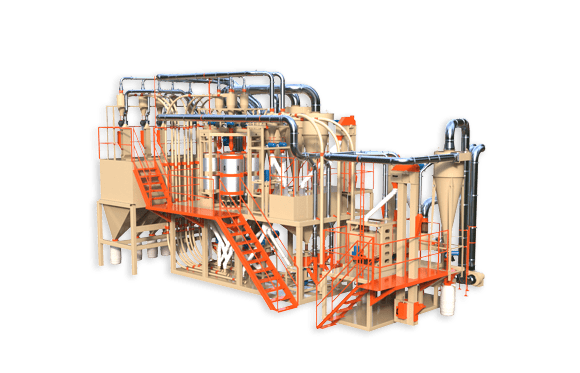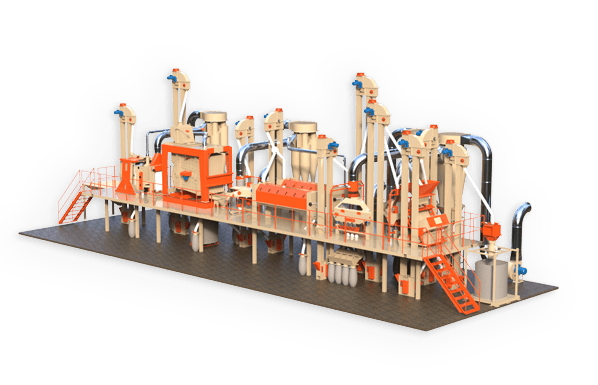Vereshchinsky A.P., General Director of OLIS LLC, Candidate of Technical Sciences
As you know, any grain mass contains grains of different sizes. The fine fraction differs in its technological properties from the large fraction. The fine fraction of wheat is characterized by low milling properties. As the grain size decreases, the specific area of its outer surface increases, which means the content of the shells and aleurone layer increases, which causes a significant increase in ash content and a decrease in nature. In addition, a significant amount of weed and grain impurities present in the wheat grain mass correspond in size to the size of its fine fraction.
Thus, the presence of a fine fraction in a grinding batch of wheat limits the possibilities of increasing the overall yield of flour and high-grade flour. In order to improve the milling properties during varietal grinding of wheat, some recommendations provide for the removal of the fine fraction and subsequent use for feed purposes. For example, according to research data [1], when removing the fine fraction (2.2×20/1.7×20), which amounted to 11.32% of the initial mass of grain, the yield of grains, dunsts and flour in the torn process from that part of the grain that got for grinding, increased by 1.28%, and their ash content decreased by 0.03%. In work [2], the data presented on the efficiency of fine fraction selection at different mills in Russia confirm the results presented above.Thus, on average, selecting 72% of fine grain grain ensures an increase in the overall flour yield by 0.9%, and high-grade flour by 1.7%.
In the table we show the economic results of real grinding carried out without selecting fine grains, and the predicted results of grinding with selecting fine grains, which were modeled according to data from [2]. The increase in the yield of high grades of flour, due to the removal of the fine fraction, was equally attributed to the highest and first grades. The fine grain fraction was considered class 6 wheat. The cost of grain and processed products was taken at average prices for the same period (the first ten days of May 2011) according to the website www.muka.zerno.kiev.ua. To simplify the calculations, the costs of processing, mechanical losses, waste and the influence of moisture were assumed to be identical in both cases, which makes it possible to ignore them when making comparisons.
Table
| Grinding 1 (without removing fine grains) | Grinding 2 (with removal of fine grains) | |
| Premium grade flour | 50% 500 kg x 3.2 UAH/kg = 1600 UAH |
47.2% (50.85% of the grain received for grinding) 472 kg x 3.2 UAH/kg = 1510 UAH |
| First grade flour | 20% 200 kg x 2.85 UAH/kg = 570 UAH |
19.3% (20.85% of the grain received for grinding) 193 kg x 2.85 UAH/kg = 550 UAH |
| Second grade flour | 5% 50 kg x 2.6 UAH/kg = 130 UAH |
3.9% (4.2% of grain received for grinding) 39 kg x 2.6 UAH/kg = 101 UAH |
| Total flour yield | 75% | 70.5% (75.9% of grain received for grinding) |
| Bran | 25% 250 kg x 1.4 UAH/kg = 350 UAH |
22.4% (24.1% of grain received for grinding) 224 kg x 1.4 UAH/kg = 314 UAH |
| Fine grain | — | 7.2% 72 kg x 1.6 UAH/kg = 115 UAH |
| Total products worth | 100% or 1000 kg 2650 UAH. | 100% or 1000 kg 2590 UAH. |
| Initial cost of 1000 kg of grain | 2000 UAH. | 2000 UAH. |
| Difference in the cost of grain and processed products | 650 UAH. | 596 UAH |
As can be seen from the table, grinding with the removal of small grains is inferior in economic results. Some improvement in the milling properties of grain as a result of this operation does not even compensate for the losses resulting from the sale of part of the grain of the grinding batch (grade 3-4) at the prices of grade 6 wheat. In addition, in terms of feed value, quality indicators and marketability, the fine fraction of wheat is significantly inferior to class 6 wheat, and therefore can only be sold at a price significantly lower than that accepted in the calculations. It should be noted that the fine fraction of wheat, as a rule, is characterized by a high content of gluten, which is not inferior in quality to other fractions. Therefore, the removal of fine grain grain in some cases can cause a decrease in the baking properties of flour. Thus, in modern economic conditions, the fractionation of wheat grain and the removal of the fine fraction from varietal grinding does not ensure the rational use of raw materials and leads to the loss of part of the profit from processing.
Obviously, fractionation of wheat can be a justified measure only if further operations are used to increase the milling properties of the fine fraction and process it with the main part of the grain into flour.
Indeed, grain fractionation creates the prerequisites for increasing the efficiency of purifying isolated fractions from impurities by reducing the load on the working parts of machines, more accurately selecting the characteristics of their working parts and operating modes.However, purification of grain of the fine fraction of wheat requires the use of complex and combined purification methods and is rarely successful, due to the characteristics of the impurities, which, together with the fine grain, form difficult to separate and inseparable mixtures. In addition, cleaning grain from impurities, as well as cleaning the grain surface in wallpaper machines, practically does not reduce its ash content. Thus, fractionation of wheat and further in-depth purification of its fine fraction cannot be a sufficiently effective solution to significantly improve the milling characteristics of the grinding batch as a whole.
It is known that an effective method for improving the milling properties of wheat is husking. Peeling treatment leads to a significant reduction in the ash content of grain and the content of impurities, incl. and those that are not isolated by simple separation. As a result, an increase in the yield and quality of flour to ensure the efficiency of preparing grain for grinding by peeling grain fractionation is not necessary. However, if technological solutions for constructing a mill make it impossible to organize the peeling of the overall grain flow, grain fractionation and peeling of only the fine fraction should be used. The features of such an operation were given in our article “Preparation of grain by peeling in varietal wheat grinding mills”, published in No. 11 of the magazine “Grain Storage and Processing” for 2009. According to the recommended scheme, the fine fraction is separated after the main conditioning stage, peeled off and, together with the main grain flow, sent to grinding. The effectiveness of such selective peeling in reducing the ash content and impurity content in the total flow of grain entering the grinding corresponds to the total efficiency of all grain cleaning equipment, well equipped according to traditional milling schemes.
Thus, removing small grains from grinding is not a viable solution, given the economic efficiency of processing. The use of peeling during grain preparation makes it possible to effectively use the fine fraction of wheat in the production of high-quality flour, which allows not only to avoid losses of raw materials, but also to obtain additional profits.
Published based on materials
“Grain storage and processing”
scientific and practical journal
№ 6 (144) June 2011
- 1. Kulik V.G., Maksimchuk B.M., Chakar A.P. Flour mills with complete equipment. – M.: Kolos 1984, – from 10.11.
- 2. Egorov E.A., Petrenko T.P. Technology of flour and cereals. – M.: MGUPP, 1999. – p.43,44.





























